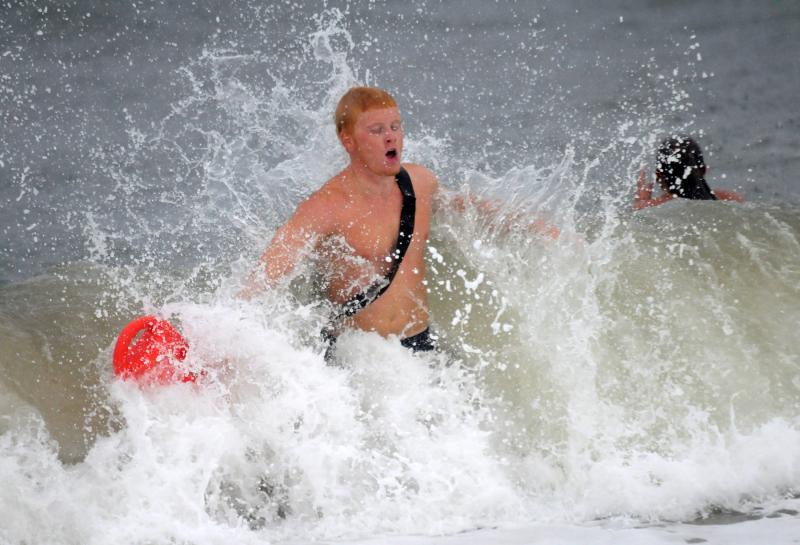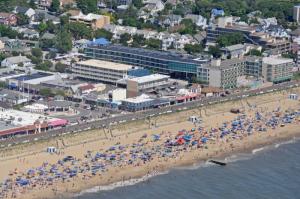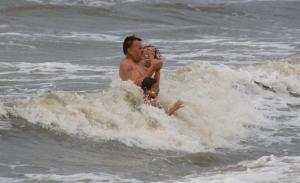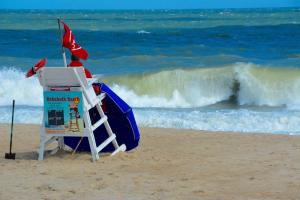Experts: Don't turn your back on the waves
Underestimating the power of waves may be one of the most dangerous things tourists – and locals – can do while at the beach.
For eight summers, doctors from Beebe Healthcare and local scientists have compiled data about surf-zone injuries and the beach environment, and found that most injuries – ranging from minor cuts and bruises to spinal cord injuries and even death – occurred while people were wading along the shoreline.
The problem? People turning their backs to the ocean, and getting slammed by the surf.
“If we could tell people one thing: Don't turn your back to the waves,” said Jack Puleo, a University of Delaware researcher on the ongoing surf-zone injury study. “Moving water is incredibly powerful.”
While rip currents are normally noted as one of the most dangerous ocean processes, fatalities in Delaware due to rip currents and surf-zone injuries are about even. Since 1998, four people have died along First State beaches from rip currents; since 2010, at least three people have died from serious surf-zone-related injuries.
Total injuries in 2016: 213
Spinal injuries (2016): 25
Total injuries in 2015: 276
Spinal injuries (2015): 17
Total injuries in 2014: 299
Cervical fractures/spinal injuries (2014): 21
Total injuries in 2013: 118
Total injuries in 2012: 262
Total injuries in 2011: 423
Total injuries in 2010: 429
Total injuries 2010-2016: 2,038
Fatalities: 3
Average age of injured person: 35
Source: Dr. Paul Cowan, Beebe Healthcare, and Jack Puleo, University of Delaware
“We can't predict rip currents, but that doesn't mean we don't try,” said Amy Williams, an ecosystem extension agent with New Jersey Sea Grant. Williams joined other scientists and about half a dozen lifeguards at a recent rip current and surf-zone safety workshop hosted by Delaware Sea Grant in Lewes.
Being on the ground, or using drones to view the waves from above, is the best way to tell when and where rip currents exist, Williams said.
That's why every morning from Memorial Day to Labor Day, around 10:15 a.m., Mid-Atlantic beach patrols join a conference call with the National Weather Service to talk about ocean conditions seen by scientists and the naked eye.
“With information from lifeguards, the National Weather Service can enhance the information they can share,” said Mike Churma of the National Weather Service. “It's an instantaneous benefit for weather reports, and the long-term benefit is the research. We're trying to sort of discern what are the triggers for rip currents. There's not just one answer.”
There's also no single answer for why so many people get injured in the surf zone, the area along Delaware beaches where waves break on the sand.
The surf-zone injury study has found no direct connection between injuries and environmental factors such as beach slope and hydrodynamics at five popular beaches – Cape Henlopen State Park, Rehoboth Beach, Dewey Beach, Delaware Seashore State Park and Bethany Beach, according to a paper that summarizes water-use data gathered in 2014.
Instead, the study suggests human tendencies may have a larger role to play when it comes to serious injuries in the surf.
Unfamiliarity may be the culprit
Always swim near a lifeguard stand.
Check in with the lifeguard to see if waves are dangerous or if rip currents are present.
Keep arms in front of you while body surfing.
Do not dive into the water if the depth is unknown.
Exit the water between waves.
Do not turn your back on the ocean without being aware of approaching waves.
Do not swim alone.
If you get caught by a rip current, do not swim against the current. Swim out of the current, then to shore. If you can't escape, float or tread water and call or wave for help.
“Results from other studies also suggest that tourists or beachgoers unfamiliar with coastal processes are more likely to suffer an accident, utilize the beach in an unsafe manner or require rescue,” the study states.
The study also found no direct correlation between beach nourishment – a state- and federally funded activity that rebuilds beaches and dunes – and injuries, despite community concerns that nourished beaches have altered profiles that make the surf zone more dangerous for beachgoers. The data do not show this is the case. Injury data was collected by Dr. Paul Cowan at Beebe Healthcare's emergency department, while environmental data was collected through various methods during the summer season. Researchers have been compiling data each summer since 2010, but a paper published in the Natural Hazards journal only examines data for 2014.
In 2005, Rehoboth Beach was nourished with sand borrowed from an offshore area heavy with gravel. Surfers and other community members argued that material, which was much more coarse than the sand normally found along Rehoboth's shores, altered the profile of the beach, causing steep drop-offs that some claimed led to an increase in injuries.
“Scientifically, we don't see a link between nourishments and increased incidents,” said Jesse Hayden of the Department of Natural Resources and Environmental Control's Shoreline and Waterway Management section.
“The observation that these nourishments steepen the beach, I think, is not the complete story,” he said. “We know there's an adjustment period where they might be steeper, but research has shown that our day-to-day variability due to the changing of forces like waves and currents, has a larger impact than the difference in steepness between nourishments.”
Since that time, officials have stopped using that borrow site and found better-quality sand for ongoing nourishment projects, Hayden said.
What can be done
Regardless of what's causing injuries, experts and lifeguards are wondering what can be done to prevent them in the first place.
With more than 2,000 surf-zone injuries reported since the study began in 2010, researchers now are developing a model that could predict when and where surf-zone injuries might occur, information that could be shared with lifeguards manning the beaches.
“The goal of the study is to reduce surf-zone injuries on the Delaware coast through modeling, understand and quantify the forces involved, and raise awareness,” said Matt Doelp, a graduate student working on the study. “We'd like to use data to predict or forecast when hazardous conditions might come up.”
The real difference may come in education and awareness, though.
There are plenty of pamphlets and warnings about rip currents – which also can prove deadly – but more information needs to be shared with the public about the basic processes of the ocean and waves.
“Wading, which doesn't seem like a particularly dangerous activity, is dangerous because if your back is to the ocean, you might think, 'Oh, the waves are kind of small today. They're not that big.' But the ocean is a dynamic place,” Doelp said.
More than 40 percent of the surf-zone injuries compiled along Delaware's five most popular beaches occurred while people were wading. Most other injuries occurred when people were body boarding, body surfing, skim boarding or diving into the water. The study found men were twice as likely as women to be injured, while tourists were six times more likely to sustain surf-zone injuries than locals.
Dr. Cowan said the most common area injured is upper extremities, followed by the lower extremity, and then torso injuries. Spinal injuries are far less frequent, he said, but those injuries can be much more devastating
“Each season, hundreds of thousands of people will swim in our beaches,” Dr. Cowan said. “So although there is risk, the actual occurrence when considering the total number of swimmers is quite low. Most days during the summer there are few or no injuries. We see injuries that are clustered together on certain days. One of the most important questions of the study is to determine what environmental factors as well as human behavior contribute to the cluster days.”
For now, all experts can do is inform the public, which includes encouraging beachgoers to always check with a lifeguard on duty before they get in the water.
“We believe the human component is a big factor here,” Puleo said.
Editor’s note: This story has been updated to properly cite the surf-zone injury study published in Natural Hazards.
























































